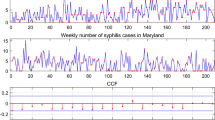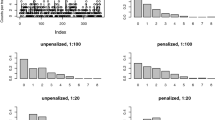Abstract
Integer-valued generalized autoregressive conditional heteroscedasticity (GARCH) models have played an important role in time series analysis of count data. To model negatively autocorrelated time series and to accommodate covariates without restrictions, the log-linear integer-valued GARCH model has recently been proposed as an alternative to the existing models. In this paper, we study a local influence diagnostic analysis in the log-linear integer-valued GARCH models. The slope-based diagnostic and stepwise curvature-based diagnostics in a framework of the modified likelihood displacement are proposed. Under five perturbation schemes the corresponding local influence measures are derived. Two simulated data sets and a real-world example are analyzed to illustrate our method. In addition, the fitted model for this example has a negative coefficient for one of the two covariates, which is particularly illustrative of the extra flexibility of the considered model.







Similar content being viewed by others
References
Atkinson, A.C.: Masking unmasked. Biometrika 73, 533–541 (1986)
Balagh, A.K.G., Naderkhani, F., Makis, V.: Highway accident modeling and forecasting in winter. Transp. Res. Part A 59, 384–396 (2014)
Brijs, T., Karlis, D., Wets, G.: Studying the effect of weather conditions on daily crash counts using a discrete time-series model. Accid. Anal. Prev. 40, 1180–1190 (2008)
Billor, N., Loynes, R.M.: Local influence: a new approach. Commun. Stat. Theory Methods 22, 1595–1611 (1993)
Bruce, A.G., Martin, R.D.: Leave-\(k\)-out diagnostics for time seres. J. Royal Stat. Soc. Ser. B 51, 363–424 (1989)
Cook, R.D.: Assessment of local influence. J. Royal Stat. Soc. Ser. B 48, 133–169 (1986)
Dark, J., Zhang, X., Qu, N.: Influence diagnostics for multivariate GARCH processes. J. Time Ser. Anal. 31, 278–291 (2010)
Douc, R., Doukhan, P., Moulines, E.: Ergodicity of observation-driven time series models and consistency of the maximum likelihood estimator. Stoch. Process. Appl. 123, 2620–2647 (2013)
Elsaied, H., Fried, R.: Robust fitting of INARCH models. J. Time Ser. Anal. 35, 517–535 (2014)
Ferland, R., Latour, A., Oraichi, D.: Integer-valued GARCH process. J. Time Ser. Anal. 27, 923–942 (2006)
Fokianos, K.: Count time series models. In: Subba Rao, T., Subba Rao, S., Rao, C.R. (eds.) Time Series Analysis: Methods and Applications. Handbook of Statistics, vol. 30, pp. 315–347. Elsevier, Amsterdam (2012)
Fokianos, K., Fried, R.: Interventions in log-linear Poisson autoregression. Stat. Model. 12, 299–322 (2012)
Fokianos, K., Rahbek, A., Tjøstheim, D.: Poisson autoregression. J. Am. Stat. Assoc. 104, 1430–1439 (2009)
Fokianos, K., Tjøstheim, D.: Log-linear Poisson autoregression. J. Multivar. Anal. 102, 563–578 (2011)
Francq, C., Zakoïan, J.-M.: GARCH models: structure, statistical inference and financial applications. Wiley, Chichester (2010)
Lawrance, A.J.: Deletion influence and masking in regression. J. Royal Stat. Soc. Ser. B 57, 181–189 (1995)
Liu, S.: On diagnostics in conditionally heteroskedastic time series models under elliptical distributions. J. Appl. Prob. 41A, 393–405 (2004)
Lu, J., Shi, L., Chen, F.: Outlier detection in time series models using local influence method. Commun. Stat. Theory Methods 41, 2202–2220 (2012)
Pedeli, X., Karlis, D.: On composite likelihood estimation of a multivariate INAR(1) model. J. Time Ser. Anal. 34, 206–220 (2013)
Poon, W.Y., Poon, Y.S.: Conformal normal curvature and assessment of local influence. J. Royal Stat. Soc. Ser. B 61, 51–61 (1999)
Schall, R., Dunne, T.T.: Diagnostics for regression-ARMA time series. In: Stahel, W., Weisberg, S. (eds.) Directions in Robust Statistics and Diagnostics (Part II), pp. 205–221. Springer, New York (1991)
Shi, L.: Local influence in principal components analysis. Biometrika 84, 175–186 (1997)
Shi, L., Huang, M.: Stepwise local influence analysis. Comput. Stat. Data Anal. 55, 973–982 (2011)
Tjøstheim, D.: Some recent theory for autoregressive count time series (with discussions). Test 21, 413–476 (2012)
Wu, X., Luo, Z.: Second-order approach to local influence. J. Royal Stat. Soc. Ser. B 55, 929–936 (1993)
Xekalaki, E., Degiannakis, S.: ARCH Models for Financial Applications. Wiley, Chichester (2010)
Ye, F., Garcia, T.P., Pourahmadi, M., Lord, D.: Extension of negative binomial GARCH model: analyzing effects of gasoline price and miles traveled on fatal crashes involving intoxicated drivers in Texas. Transp. Res. Record 2279, 31–39 (2012)
Zevallos, M., Hotta, L.K.: Influential observations in GARCH models. J. Stat. Comput. Simul. 82, 1571–1589 (2012)
Zhang, X.: Assessment of local influence in GARCH processes. J. Time Ser. Anal. 25, 301–313 (2004)
Zhang, X., King, M.L.: Influence diagnostics in generalized autoregressive conditional heteroscedasticity processes. J. Bus. Econ. Stat. 23, 118–129 (2005)
Zhu, F.: A negative binomial integer-valued GARCH model. J. Time Ser. Anal. 32, 54–67 (2011)
Zhu, F.: Zero-inflated Poisson and negative binomial integer-valued GARCH models. J. Stat. Plan. Inference 142, 826–839 (2012a)
Zhu, F.: Modeling overdispersed or underdispersed count data with generalized Poisson integer-valued GARCH models. J. Math. Anal. Appl. 389, 58–71 (2012b)
Zhu, F.: Modeling time series of counts with COM-Poisson INGARCH models. Math. Comput. Model. 56, 191–203 (2012c)
Zhu, F., Li, Q., Wang, D.: A mixture integer-valued ARCH model. J. Stat. Plan. Inference 140, 2025–2036 (2010)
Zhu, F., Wang, D.: Diagnostic checking integer-valued ARCH\((p)\) models using conditional residual autocorrelations. Comput. Stat. Data Anal. 54, 496–508 (2010)
Zhu, F., Wang, D.: Estimation and testing for a Poisson autoregressive model. Metrika 73, 211–230 (2011)
Zhu, H.T., Lee, S.Y.: Local influence for incomplete data models. J. Royal Stat. Soc. Ser. B 63, 111–126 (2001)
Acknowledgments
We are very grateful to three reviewers for valuable suggestions and comments which greatly improved the paper. We also would like to thank Dr. Fan Ye at Texas A&M University for providing the road crashes data. Zhu’s work is supported by National Natural Science Foundation of China (Nos. 11371168, 11271155), Specialized Research Fund for the Doctoral Program of Higher Education (No. 20110061110003), Science and Technology Developing Plan of Jilin Province (No. 20130522102JH) and Scientific Research Foundation for the Returned Overseas Chinese Scholars, State Education Ministry. Shi’s work is supported by National Natural Science Foundation of China (Nos. 11161053, 11361071, 11261064) and Key Project of NSFC (Yunnan Joint Project) (No. U1302267).
Author information
Authors and Affiliations
Corresponding author
Appendices
Appendix 1. The first and second derivatives of \(\nu _t\)
We obtain \(\partial \nu _t/\partial \theta \) and \(\partial ^2\nu _t/\partial \theta \partial \theta ^\top \) from above equations, and then obtain \(\partial ^2l_t(\theta )/\partial \theta \partial \theta ^\top \) with \(\partial ^2l_t(\theta )/\partial \theta _k\partial \theta _l\) given in (4) as the \((k,l)\)-th element.
Appendix 2. The required derivatives in Sect. 4.3
where
\(\partial \nu _t/\partial \theta \) and \(\partial ^2\nu _t/\partial \theta \partial \theta ^\top \) are given in Appendix 1, and
These derivatives will be evaluated at \(\theta =\hat{\theta }\) and \(\omega =\omega _0\).
Appendix 3. The required derivatives in Sect. 4.5
where
\(\partial \nu _t/\partial \alpha _0,\partial \nu _t/\partial \beta _j(j=1,\ldots ,q)\) and \(\partial ^2\nu _t/\partial \theta \partial \theta ^\top \) are given in Appendix 1, \(\psi (x)=\mathrm{d}\log \Gamma (x)/\mathrm{d}x=(\mathrm{d}\Gamma (x)/\mathrm{d}x)/\Gamma (x)\) is the digamma function, \(\psi '(x)\) is the first derivative of \(\psi (x)\) and is known as the trigamma function. These derivatives will be evaluated at \(\theta =\hat{\theta }\) and \(\omega =\omega _0\).
Rights and permissions
About this article
Cite this article
Zhu, F., Shi, L. & Liu, S. Influence diagnostics in log-linear integer-valued GARCH models. AStA Adv Stat Anal 99, 311–335 (2015). https://doi.org/10.1007/s10182-014-0242-4
Received:
Accepted:
Published:
Issue Date:
DOI: https://doi.org/10.1007/s10182-014-0242-4
Keywords
- Log-linear integer-valued GARCH models
- Slope-based diagnostics
- Stepwise local influence analysis
- Perturbation scheme




